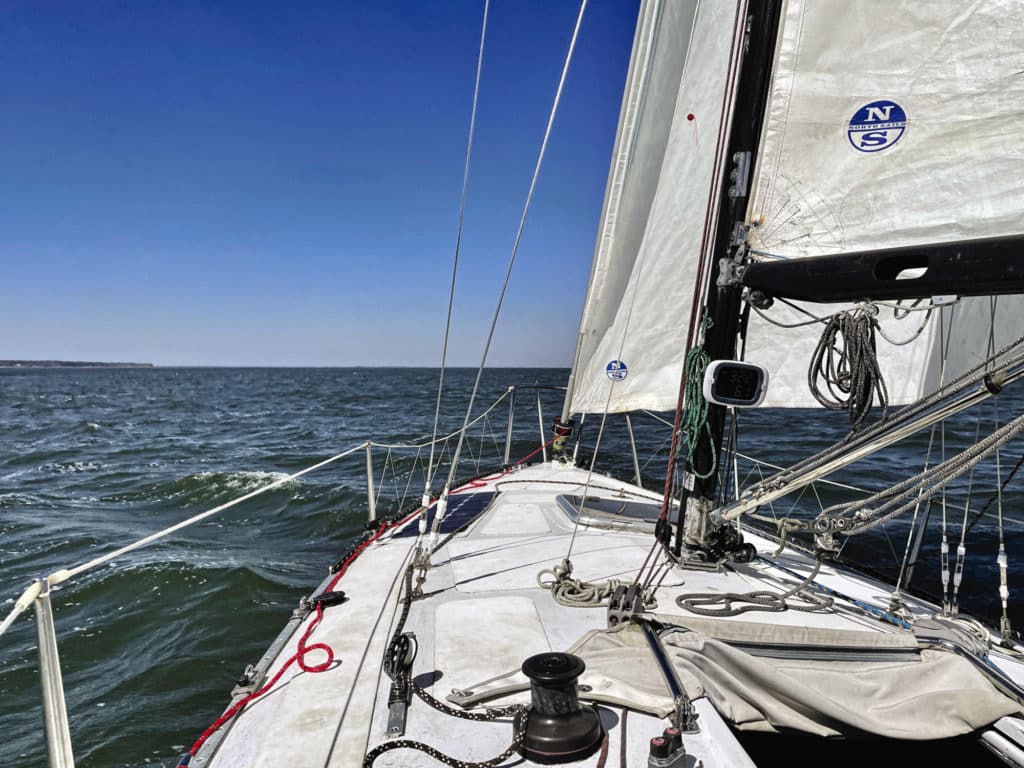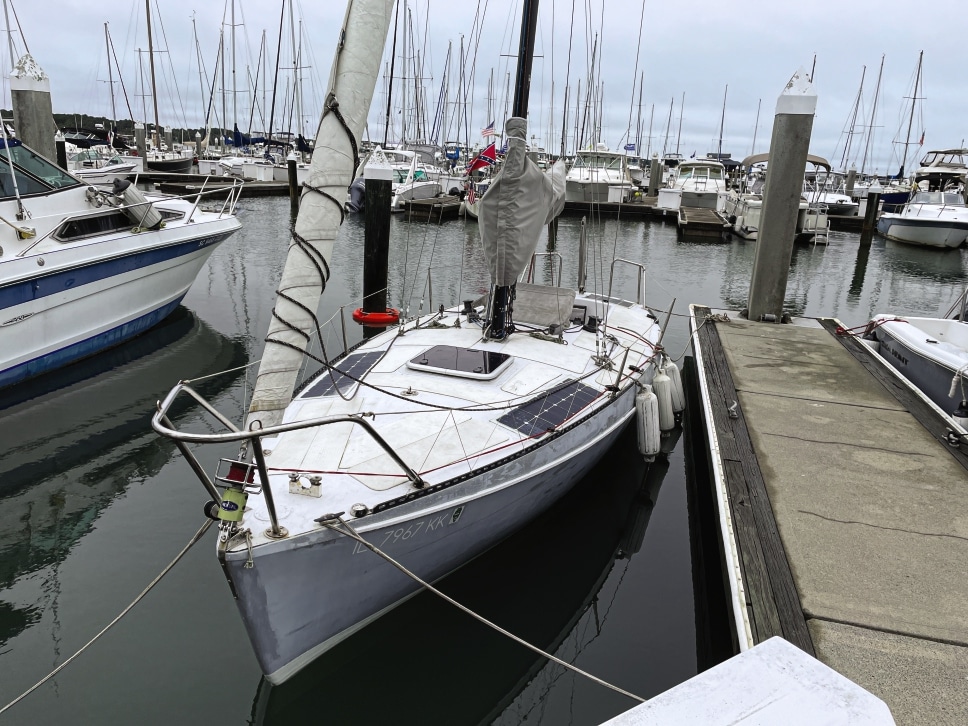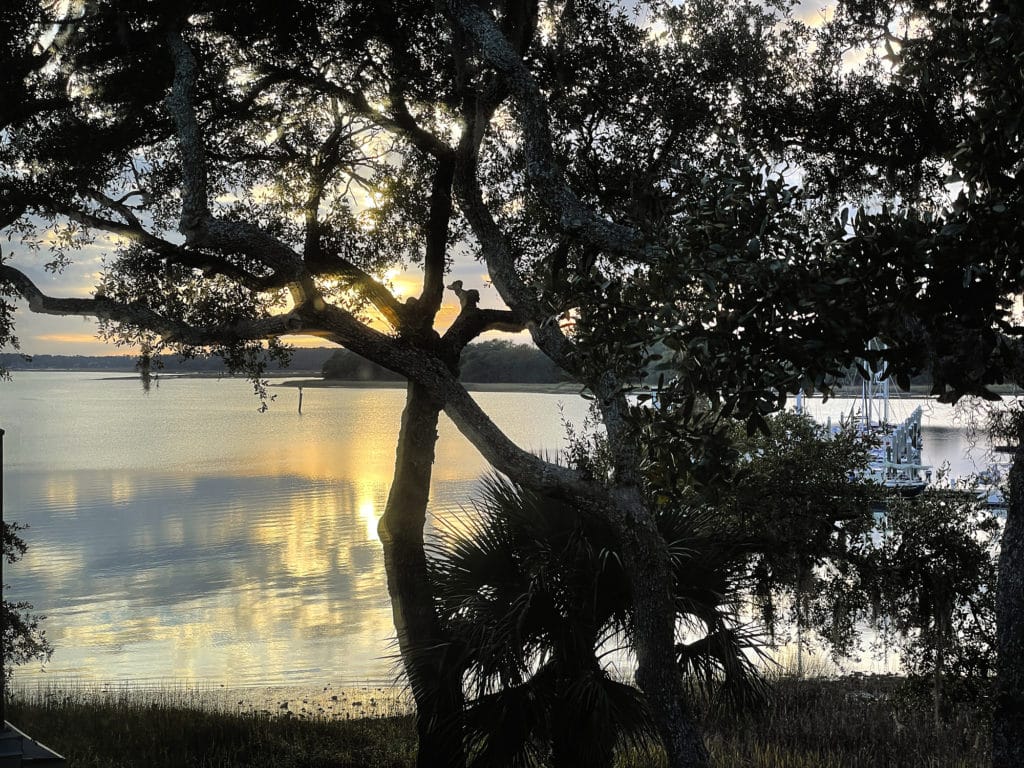
I have been called a serial circumnavigator. Among other things. I do like to go around in circles, and so at 9 a.m. on a Tuesday morning in late February, I walked down from our condominium on South Carolina’s Hilton Head Island overlooking Skull Creek Marina, where my Moore 24, Gannet, is docked, to prepare her for another epic voyage: my seventh circumnavigation. Well, really not so epic. The first six were around the planet. My seventh would be somewhat more modest: around Hilton Head Island. § Getting ready took a while. Gannet is no longer self-sufficient. When really voyaging, I can leave and return to the little boat with nothing more than the devices I carry in my messenger bag. No longer. I’ve removed as much from her as possible, including the Jordan drogue, clothes and most food. I had to fill water containers, stow equipment and food, fit the Torqeedo and check that it started. It did. I needed to fit a tiller pilot. Put the Velocitek in its mast mount. Move the anchor and rode-deployment bag from the bow to beneath the forward hatch. Remove the mainsail and the tiller covers and the covers for the compass and the depth finder. It takes almost as long to prepare for a daysail as to prepare to cross an ocean, which is one of the reasons I cross oceans more
than I daysail. In all, it took me more than an hour, but at 10:30, I was ready. I undid the line to my new pile float and realized that I had placed the bracket on which I intended to hang the line too high on the piling. I tried tossing it up there two or three times and gave up and dropped the loose end in the water.
I pushed Gannet out of her slip. The wind was northwest at 8 knots, pushing her back in, but the tide was ebbing, which partially neutralized that. I leapt on board and put the Torqeedo in reverse until we were clear enough to go forward.
We were heading around Hilton Head Island counterclockwise, roughly a 32-nautical-mile loop. The northwest wind was behind us and perfect. I unfurled the jib, feeling resistance from one of the lead blocks on the furling line that I needed to replace. I set the Autohelm to steer, stopped the Torqeedo, and tilted it out of the water. It had been on for seven minutes, and its work for the day was done. Water began to ripple past the hull as I brought in fenders and dock lines.

Past the marina, Skull Creek runs south for almost 2 miles. I’ve sailed this way only once before, and that was when I left Hilton Head for Panama two years earlier during my previous circumnavigation. I was careful to stay between the Intracoastal Waterway markers. The water in the channel is 20 feet deep. In places just outside the channel, it’s only 1 or 2 feet deep.
Familiar restaurants on the shore seemed to fly past. Dockside. Hudson’s. The wind was on the beam and gusty, heeling and rounding up the little boat sometimes more quickly than the Autohelm could respond. At the turn at the marker at the bend to the west, we came hard on the wind. I sheeted in the jib and took the tiller myself. Two powerboats had just come under the bridge and were heading toward us. I hoped they understood sailboats well enough to know that if I were headed by the breeze, I would have to cut across their bows. I had no room to tack away. But I was not confident that they did.
Gannet was heeled well over and making 6 knots under her small jib alone. Smooth water. The wind held steady. Fine sailing, but I was relieved when I could ease the sheet and fall off for the opening beneath the center of the bridge, which is the only way on and off the island. The mast height on Gannet is not a worry. A small powerboat was tied to a bridge piling with a man on board fishing. After a brief lull in the bridge’s wind shadow, we were through.
RELATED: Upgrades for a Circumnavigation
A curving half-mile past the bridge, the channel turns south again. I don’t know where Skull Creek ends and Calibogue Sound begins. Perhaps at the bridge itself. With the wind now on the starboard quarter, I set the mainsail, and our speed rose again to 6 and 7 knots. And then Gannet went out of control, rounded up, and headed for a nearby shoal. I glanced down and saw that the plastic end fitting on the tiller-pilot arm had broken. I grabbed the tiller, got us under control, and when the sound opened wider, turned Gannet into the wind, loosely hove to. I slipped into the cabin, where I grabbed another tiller pilot, returned to the cockpit, and swapped out the old one. Back on course, the sailing was glorious. Good wind. Smooth water. Warm sunshine. February.
My plan had been to anchor somewhere near the south end of the island, but we were off Harbor Town at noon and no sailor wants to waste good wind, so I decided to keep going.
We passed Hilton Head’s South Beach at 12:30. Evanston, Illinois, where we also live, also has a South Beach. At that moment, it was covered by 2 feet of snow. A woman walking on the beach waved at Gannet. I waved back for Gannet, which was busy sailing and unfortunately has no hands.

Hilton Head Island is 11 miles long and shaped like a shoe running northeast-southwest. We were rounding the toe and heading up the sole of the shoe, which is an almost continuous white-sand beach that is perhaps Hilton Head’s chief tourist attraction. However, you don’t make a sharp turn and you don’t sail close to the shore. Shoals extend out 2 to 3 miles. The channels are marked, but I kept close watch on the depth sounder and our position on the iSailor chart on my iPhone. Finally, we were able to make the turn to the northeast 3 miles offshore. As soon as we did, the wind went behind us and died.
We drifted for a few minutes before a slight exhalation filled the sails, and Gannet began to slip along at 2 to 3 knots. At least there were no waves to collapse the sails. The Atlantic was as flat as the sheltered water on the landward side of the island. I wished for more wind, but at least we were moving. There are worse places to be on a sunny winter afternoon than on a small sailboat gliding across smooth water.
As the hours passed, I watched the shore a couple of miles to port and saw two ships a few miles to starboard heading for the Savannah River, and I began to consider where I would spend the night.
Gannet’s outboard is an electric Torqeedo. I like it for several reasons. It breaks down into three parts, and is easy to mount and remove from the transom. It is quiet. It is clean. It precludes my having to carry gasoline and oil on board. Its battery can be charged from Gannet’s solar-powered electrical system. But it has drawbacks too. It’s expensive and has limited range. Just what Gannet’s range was at that moment I did not know. I had three Torqeedo batteries on board. One was 10 years old, which hadn’t be used in a long time and might be dead. The other two were probably good for 6 to 8 miles, each powering at 2.5 to 3 knots in smooth water and not against wind or tide.
At 5 p.m., we were nearing the north end of Hilton Head Island and the entrance into Port Royal Sound. Sunset would be at 6 p.m. I could certainly lower the Torqeedo back into the water, power into the sound and anchor there for the night, but the Atlantic Ocean was as smooth as a good harbor, and I was reasonably certain that the night would be calm.
Ten minutes before sunset, we were in 35 feet of water, 1.5 miles off the northeast corner of the island and a half-mile south of a buoy marking the dredged channel into the sound. I went forward, pulled the spade anchor and deployment bag onto the deck, and anchored. As I made my way aft, I was facing east. The nearest land was Bermuda, 800 miles away. I figured it would provide sufficient shelter, so I went below to turn on the masthead anchor light and pour myself a drink, which I took on deck with my Boom 2 speakers, and sipped and listened to Bach.
Dinner was freeze-dried beef stew, bought three years earlier, with the water heated on the JetBoil stove. Old times.
At sea, I sleep on the windward pipe berth. Well, we were technically at sea, but neither berth was to windward, and I had removed the berths to have the covers replaced. So I retired for a quiet night on the V-berth. A few years earlier, the eye of Category 5 Hurricane Matthew passed near where we were anchored. Timing is almost everything.
Secure in the lee of Bermuda, which had an unusually long wind shadow that evening, Gannet barely moved during the night, and I slept well. I woke a couple of times and went to the companionway, where I saw Hilton Head where it should be and the green buoy where it should be.
The sun came up, but the wind didn’t.
I ate my invariable sailing breakfast in the cockpit. I had brought a bottle of grapefruit juice with me, but my other provisions—instant coffee, uncooked oatmeal, whey protein power, trail mix, dried fruit and powered milk—had been on board since at least before I had Gannet trucked from San Diego to Hilton Head the previous Labor Day weekend, and probably much longer. They were all as tasty as ever, though some might disagree.
Through a bright, sunny, pleasant morning I waited, mostly reading Jonathon Raban’s Bad Land in the cabin to stay out of the sun, going on deck from time to time to watch bubbles drift past on the outgoing tide and to futilely look for any sign of wind.
RELATED: Webb Chiles Completes Sixth Circumnavigation
I decided that if there were no wind by noon, when the tide would turn in our favor, I would lower the Torqeedo and power into the sound. While my course the previous day had lots of curves and turns, I calculated that I had covered 24 miles and that I had 10 more to go to reach Gannet’s slip. I had no pressure of time. No need to be back in the marina that day and could anchor in the sound and wait for wind on Thursday. I just didn’t feel like staying where I was any longer.
A few minutes before noon, I was kneeling at the stern, preparing to tilt the Torqeedo into the water, when I felt a breath on my back. I turned and saw a line of darker wind-ruffled water to our south. I left the Torqeedo as it was, and made my way forward and raised the anchor. It came up clean. Hilton Head’s long white-sand beach must extend offshore.
After lowering the anchor and rode-deployment bag onto the V-berth, I raised sails, and Gannet began to gather way.
For the first mile, our course was north; then in the sound, northwest. Wind on our beam steadily increased to 12 and 14 knots, and moved forward when we turned. Still smooth water, only 6-inch ripples. More glorious sailing at 6 to 8 knots.
Several rivers pour into Port Royal Sound and the tides have carved out 40- and 50-foot depths, but there are isolated and mostly unmarked shoals. I am beginning to know these waters, but I continue to pay close attention to the depth sounder and the charts on my iPhone.
Gannet dashed along. The contrast was great between this and the afternoon before and the 18 hours we sat at anchor becalmed. Gannet sails so well in almost any wind, but she does need some.
As we neared the red and green markers at the mouth of Skull Creek, the wind was blowing 14 knots directly out. I didn’t feel like short-tacking the last 1.8 miles in the Intracoastal’s channel around a bend in the creek, so I furled the jib, lowered the Torqeedo into the water and started it, and lowered the main.
A sand spit to the north of the creek entrance was covered with birds: sea gulls, cormorants and one pelican. While Gannet’s 2-foot freeboard does not offer much windage, her ultralight weight does not carry far, and the headwind slowed us.
A few other boats passed, mostly power but a few sail. Those on board waved at the old man on his little boat. I’m sure they thought how nice it is that he still gets out on the water. The old man waved back.
As we rounded the curve and pointed at the marina, I put out fenders and dock lines, and we powered slowly into Gannet’s slip, tying up at 2:30 p.m. Circle completed.
Gannet’s second circumnavigation and my seventh was by far the most uneventful and the most pleasant. Amateurs seek adventures; professionals seek to avoid them. We had no undesired adventures. We did have a fine time.
Webb Chiles is a writer and sailor, and has solo-circumnavigated seven times, on a variety of boats. You can follow his adventures at inthepresentsea.com.








